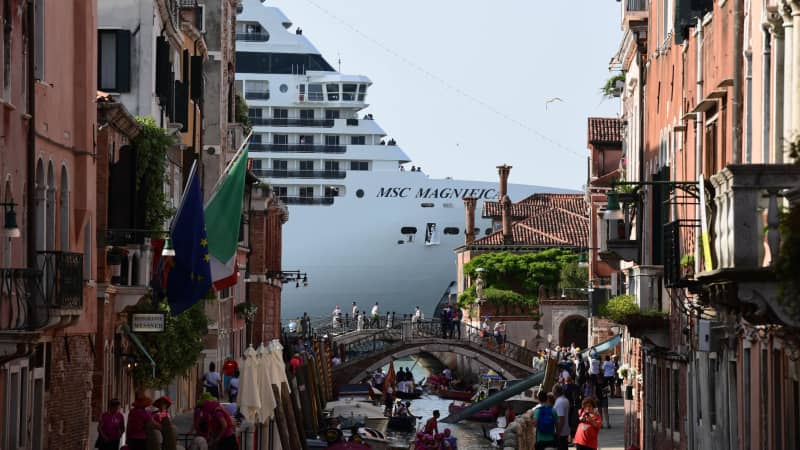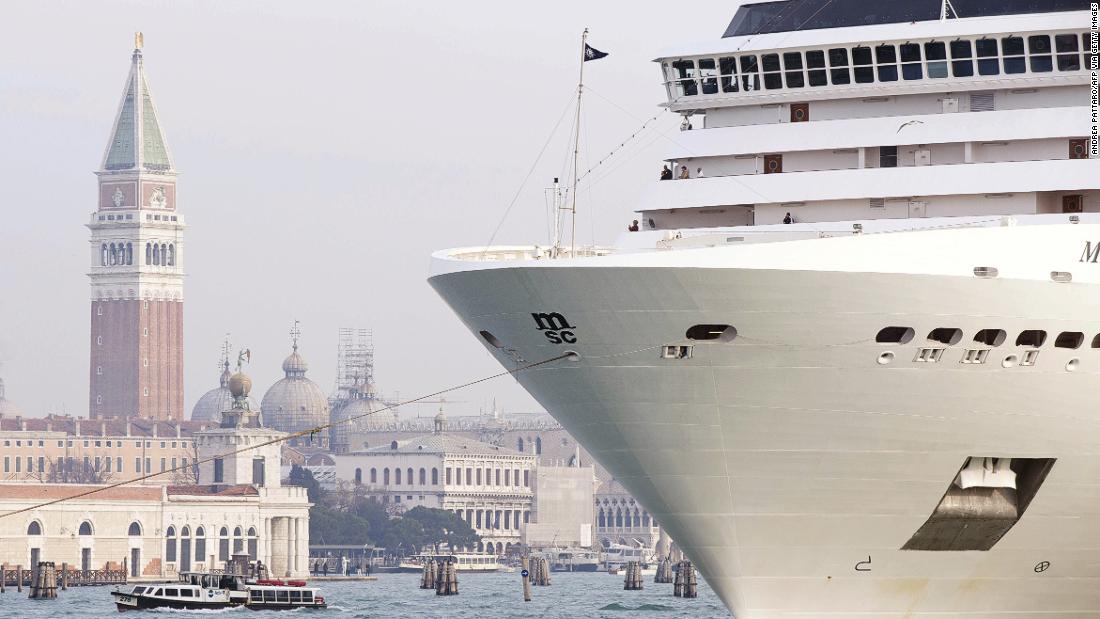(CNN) — For those on a Mediterranean cruise, it’s one of the most memorable sights: the city of Venice unpeeling beneath the boat, the centuries-old buildings and bell towers dwarfed by the ship, giving onlookers a spectacular bird’s eye view.
But for many on the shore, cruise ships in Venice have come to symbolize the excesses of modern tourism — the type that can unleash thousands of visitors on a city ill equipped to deal with them on a “hit and run” visit to see the sights, but not spend any money in the local economy.
For years, campaigns to oust cruise ships from the lagoon have been gaining traction, with locals claiming that the ships’ massive structures erode the seabed, effectively turning the lagoon into an offshoot of the Adriatic Sea.
And now, finally, the Italian government has agreed with them, passing a decree to ban cruise ships and other large vessels from the lagoon.
“Anyone who has visited Venice in recent years has been shocked to see these ships, hundreds of meters long and as tall as apartment buildings, passing through such fragile places,” he said following the vote.
A new port in the Adriatic Sea

The MSC Magnifica cruise liner ship passes near St Mark’s Square in Venice’s basin on January 23, 2011.
ANDREA PATTARO/AFP via Getty Images
The government will now hold public consultations about the possibility of building terminals outside the lagoon.
This means that previous plans to route ships to Marghera and Fusina — both on the mainland, but inside the Venice lagoon — will not be possible.
Previously, the authorities had agreed to reroute large ships away from the basin of St Mark’s and the Giudecca Canal — where the ships are just meters away from the city center — but to have them dock in Marghera.
This wasn’t enough for campaigners, however, who say that the very presence of large ships in the lagoon is destroying the environment.
The succession of major floods in recent years has been attributed in part to global warming, but in part, some say, to the erosion of the lagoon.
The tension between those pro and anti cruise ships has been mounting in recent weeks.
Over 4,000 locals work at the port, and are among the Venetians who have lost their livelihoods during the Covid-19 pandemic.
But others, backed up by UNESCO, say that the ecological damage being caused by the cruise ships — and the overtourism that they contribute to — must carry more weight.
Only last month, the No Grandi Navi pressure group was fined €20,000 ($23,500) for blocking the exit of three cruise ships from the port in 2017. A crowdfunder to pay their fines included donations from the likes of actress Emma Thompson, who has a home in Venice. The group were not available for comment today.
Cinzia Zincone, Extraordinary Commissioner for the Autorità di Sistema Portuale del Mare Adriatico Settentrionale, which runs the Port of Venice, said in a statement to CNN that it will guarantee “collaboration” in looking at new solutions, but warned that any proposals “must respect safety criteria, environmental compatibility, and safeguard the essence of the Venice homeport in the cruise sector.”
The port had already, last month, opened for tenders to design a new cruise terminal at Marghera, after a government committee ruled in December that large ships should dock there, but smaller ones could continue to use the current city port.
‘A capital of sustainability’

Venetians have been used to the city being dwarfed by the ships.
Miguel Medina/AFP/Getty Images
She called for the city and port authority to ban any new channels being dug in the lagoon, and to create “cold-ironing infrastructures” which would allow ships to connect to electrical power when docked, rather than keeping their engines running.
She also called for cruise companies to contribute financially to the new port, and for a “low impact shuttle system” to be brought in for tenders taking passengers into the lagoon.
“Venice claims to want to become a capital of sustainability,” she added.
“Regulating the cruise industry is a crucial step to do so. As one of the main ports of the Mediterranean, Venice has the power to move the needle.
“We’re asking the city to be courageous and set an example.”
It isn’t the first time the authorities have tried to ban cruise ships.
